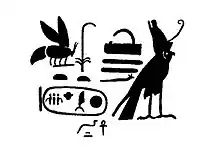| Iyibkhentre | |||||||||||||||||||||||||||||||||||||||||||||
|---|---|---|---|---|---|---|---|---|---|---|---|---|---|---|---|---|---|---|---|---|---|---|---|---|---|---|---|---|---|---|---|---|---|---|---|---|---|---|---|---|---|---|---|---|---|
 Drawing of an inscription depicting Iyibkhentre's titulary. | |||||||||||||||||||||||||||||||||||||||||||||
| Pharaoh | |||||||||||||||||||||||||||||||||||||||||||||
| Reign | early 20th century BCE | ||||||||||||||||||||||||||||||||||||||||||||
| |||||||||||||||||||||||||||||||||||||||||||||
| Dynasty | 11th–12th Dynasty | ||||||||||||||||||||||||||||||||||||||||||||
Iyibkhentre was an ancient Egyptian or Nubian ruler who most likely reigned at the end of the 11th and beginning of the 12th Dynasty.
Biography
He could have been a pretender to the Egyptian throne headquartered in Lower Nubia, during the politically sensitive period within the reign of Mentuhotep IV of the 11th Dynasty and the early reign of Amenemhat I of the 12th Dynasty.[1][3] In fact, both those rulers seem to have had problems in being universally recognized as legitimate pharaohs.
Hungarian Egyptologist László Török suggested a much more recent dating for Iyibkhentre (as well as for the other related rulers mentioned below), some time after the reign of pharaoh Neferhotep I of the 13th Dynasty (Second Intermediate Period).[4]
Iyibkhentre adopted the pharaonic royal titulary, although only the Horus name and the Throne name are known from rock inscriptions at Abu Hor, Mediq and Toshka, all in Lower Nubia.[5]
Like Iyibkhentre, two other rulers based in Nubia, Segerseni and Qakare Ini, likely were pretenders to the Egyptian throne, but the eventual relationships among the trio are unknown.
References
- 1 2 Jürgen von Beckerath, Handbuch der ägyptischen Königsnamen, Deutscher Kunstverlag, München/ Berlin 1984, ISBN 3-422-00832-2, pp. 64, 195.
- ↑ Arthur Weigall, A Report on the Antiquities of Lower Nubia. Cairo 1907, pls. 49–50.
- ↑ Wolfram Grajetzki, The Middle Kingdom of ancient Egypt: history, archaeology and society. London, Duckworth Egyptology, 2006, pp. 27-28.
- ↑ László Török, Between Two Worlds: The Frontier Region Between Ancient Nubia and Egypt 3700 BC - 500 AD, Brill, 2008, ISBN 978-90-04-17197-8, pp. 100–102.
- ↑ Thomas Schneider, Lexikon der Pharaonen. Albatros, Düsseldorf 2002, ISBN 3-491-96053-3, p. 137.
- Henri Gauthier, "Nouvelles remarques sur la XIe dynastie", BIFAO 9 (1911), pp. 99–136.
